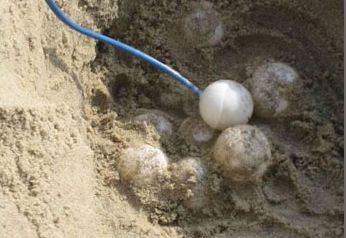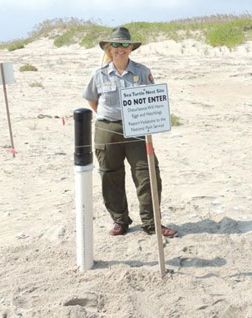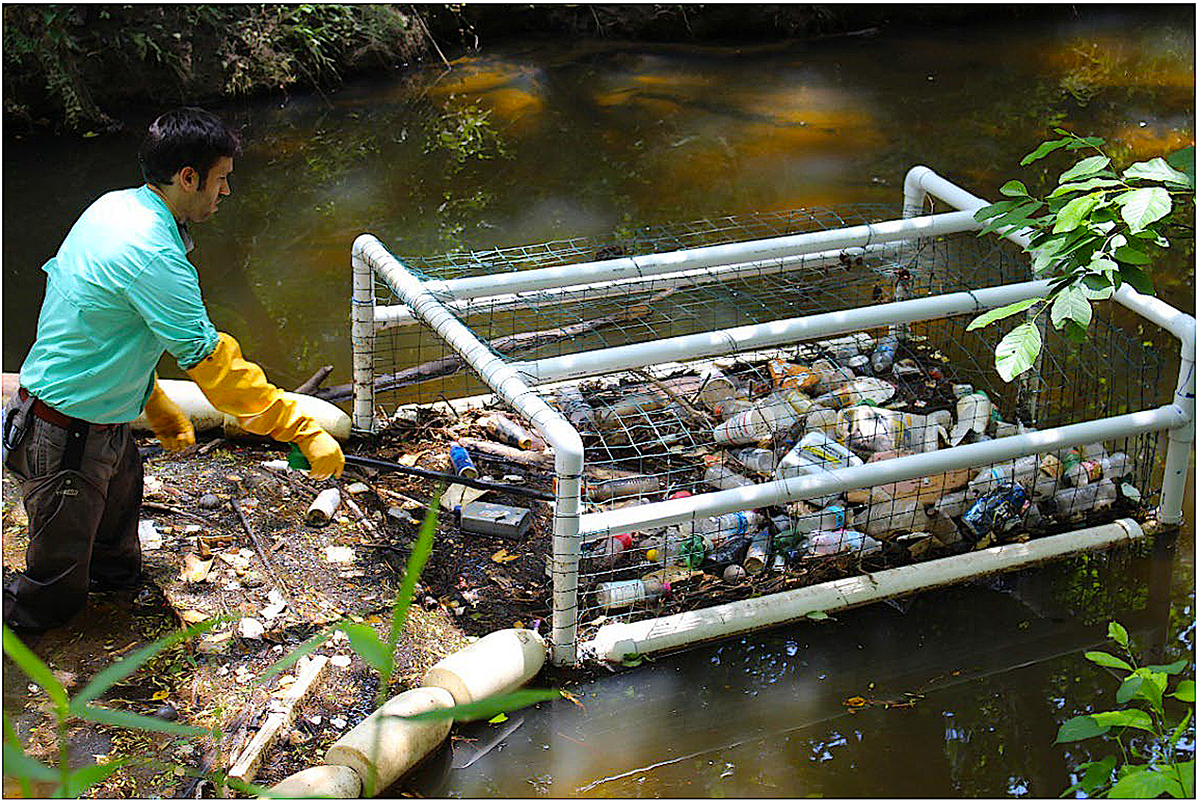Reprinted from the Island Free Press
HATTERAS — Think of a sea turtle nest as a baby about to be born, and the volunteer nest watchers and National Park Service biologists as the pacing family members — waiting, waiting, waiting.
Supporter Spotlight
When Eric Kaplan, a Frisco homeowner and founder of the Hatteras Island Ocean Center, realized how much time, money and energy went into management of sea turtle nests in Cape Hatteras National Seashore, he saw the solution in modern wireless technology that could pinpoint the hatch date.
“The best way to describe it,” Kaplan said, “is we’ve given cell phones to turtles. ”
 The sensor is the size of a ping pong ball and made to mimic a turtle egg. The cable leads to a communications equipment above ground that will make a cell phone call. Photo: Island Free Press |
If sensors can help biologists narrow down the hatch window for eggs during the six week nesting period, protective beach closures around nests could be drastically reduced.
That translates to fewer resources that will be required by the park to protect the more than 100 nests found on its beaches in an average year.
By law, park biologists must protect sea turtles. Staff and volunteers keep track of where turtles nest, and 50 days after the eggs are laid, they fence off a swath of beach from the nest to the ocean. The area is closed to off-road vehicles and pedestrians until the eggs hatch and the nest has been excavated by park staff, or until 100 days has passed.
Supporter Spotlight
The prolonged closures create conflict for recreation users of the beach, Kaplan said, but the sensors could eliminate the need for any more than one to three days of closures around nests.
“We want turtles and people to co-exist on the beach,” he said. “And that will help our economy.”
It will also lead to more cost-effective turtle management, Kaplan said. Once the kinks are worked out, there could be an eco-tourism opportunity where folks could be invited to see the babies boil out of the nest and waddle their adorable selves to the ocean.
Beach drivers should be pleased to know that the Park Service is providing their share of costs for the project out of its ORV permit fees.
“There are no losers with this,” Kaplan said.
Kaplan, who built his Frisco home in 2009, is a semi-retired software designer who found success in making Bluetooth wireless technology consumer-friendly, so it wasn’t an enormous leap for him to design a small polyurethane “egg” with a wireless sensor to put in a nest.
When the sensor detects temperature change and movement that indicate an impending hatch, the data is sent to a cell phone network, collected by special software and monitored remotely by someone on a computer. In the near future, he said, the hope is that software will automatically analyze the data.
“It really wasn’t like it was a particularly insightful idea,” Kaplan said. “It makes sense.”
Launched last year, the program, now aptly known as Turtle Sense, is a cooperative partnership between the seashore, Kaplan and Nerds Without Borders, a charitable venture created by tech innovators.
 Britta Muiznieks, a biologist with the National Park Service, stands next to a PVC pipe that houses the communications equipment. Photo: National Park Service |
Kaplan’s childhood buddy, Tom Zimmerman, an electrical engineer with IBM Research-Almaden, designed the sensor package in 2013 as a contribution from IBM.
Another friend, Samuel Wantman, a retired software designer, also worked on development of the first phase of the design. Wantman is now managing the project under the umbrella of the Nerds organization and is being assisted by other tech wizards.
Kaplan and the Nerds – whom he called “like-minded people who want to get together to make the world a better place” — are all donating their time.
“To me, it was becoming vested in the community,” Kaplan said about his contribution, “and not being someone who takes from the community.”
All the technology and software is open-source and available to anyone to use.
“Any place you need remote monitoring, or to measure stuff, this could be used,” Kaplan said.
Earlier this month, for the first time, a turtle hatch was successfully predicted in one of the 17 nests that have sensors in them. That means, Kaplan said, that the fundamental technology is working. Tweaking and fine-tuning will continue over the next few seasons.
The challenge, he said, has been to make the sensors very low power and able to withstand the harsh environment on the beach. Consequently, as many wires as possible must be eliminated and the “egg” needs to be completely sealed from the elements.
The immediate goal is to get the cost of the sensors down to about $100 a piece, he said. Once it takes off, they could reasonably be expected to go as low as $10 each.
Britta Muiznieks, a park wildlife biologist overseeing research projects, said that a sensor in another test nest had also showed activity. When it was checked, the nest had a lot of overwash and it was not clear if it was about to hatch or had hatched. But three days later, she said, it was determined by counting the shells that 95 percent of the eggs had hatched successfully.
At a second nest, however, Muiznieks received an e-mail the night before the nest hatched that there was activity. It turns out, she said, that the nest “boiled” – the hatchlings emerged all at once — that evening, and the next morning, 55 turtle tracks were counted heading to the ocean, and more live hatchlings were found still in the nest.
“These first nests are helping us establish a baseline,” she said. “In the future, I think it has very good potential.”
Muiznieks said that the Park Service has been looking for innovative ways to do things, known in park-speak as adaptive management.
To her knowledge, she said, it is the first time that such technology has been used successfully in management of protected species. She said that she could see an application of it being used in management of endangered or threatened birds.
“We’ve been lucky – Eric has these connections in the high-tech world,” she said. “We don’t have access to these sorts of things. It’s been a really great partnership.”







